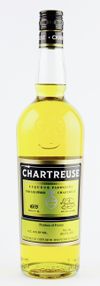Chartreuse

Chartreuse is a strong and famous French liqueur composed of distilled wine alcohol flavored with various herbal extracts. The liquor is named after the monastery in which it is produced, which in turn is named after the mountainous region where it was built. The color chartreuse is a green and slightly yellow color resembling that of the green chartreuse beverage.
There are two main types of Chartreuse:
- Green Chartreuse (110°) is a naturally green liquor flavored with extracts from 130 plants
- Yellow Chartreuse (80°) has a milder and sweeter flavor
There are different other kinds of Chartreuse:
- Chartreuse VEP
- Liqueur du 9ème Centenaire
- Charteuse 1605
According to tradition, in 1605 a marshal of artillery to French king Henri IV, François Hannibal d'Estrées, made a gift to the Carthusian monks at Vaubert, near Paris, in the form of a manuscript containing a complicated recipe for an "elixir of long life". The recipe eventually reached the religious order's headquarters at Grande Chartreuse at Voiron, near Grenoble, and has been used since the recipe was decoded in 1737 to produce the 142° Elixir Vegetal de la Grande Chartreuse. The formula was said to call for 130 herbs, flowers, and secret ingredients combined with a brandy base. The monks intended their liqueur to be used as medicine; it has 71% (vol.) alcohol (142° proof) and is colored with chlorophyll. It is sold today under the name Elixir Végétal de la Grande-Chartreuse.
The beverage became popular quickly, and in 1764 the monks adapted the elixir recipe to make the somewhat milder and less alcoholic Green Chartreuse. In 1793, the monks were expelled from France, resulting in the interruption of the manufacture of Chartreuse. Several years later they were allowed to return to their monastery. In 1838, the monks developed a sweeter variation that has 40% (vol.) alcohol (80° proof), colored with saffron and sold as yellow chartreuse. The exact recipes for these liquors remain a trade secret of the Carthusian monks, and are known to only three of the monks at a time. The monks were again expelled from the monastery in 1903. Finding refuge in Tarragona, Spain, they began producing Chartreuse under a different name. Because the French government had confiscated most of the possessions of the Order, including the trademark Chartreuse, the monks began inscribing the labels on the bottles Liqueur fabriquée à Tarragone par les Pères Chartreux.
In 1938, the monks were allowed to return to their old monastery and resumed production of Chartreuse under the original name. Today the liquors are produced in Voiron using the herbal mixture prepared by three monks at the Grande Chartreuse. Other related alcoholic beverages are manufactured in the same distillery (e.g. Génépi).
In the short story "Reginald on Christmas Presents" (contained in the 1904 collection Reginald by Edwardian English author Saki), the title character declares that "people may say what they like about the decay of Christianity; the religious system that produced green Chartreuse can never really die."